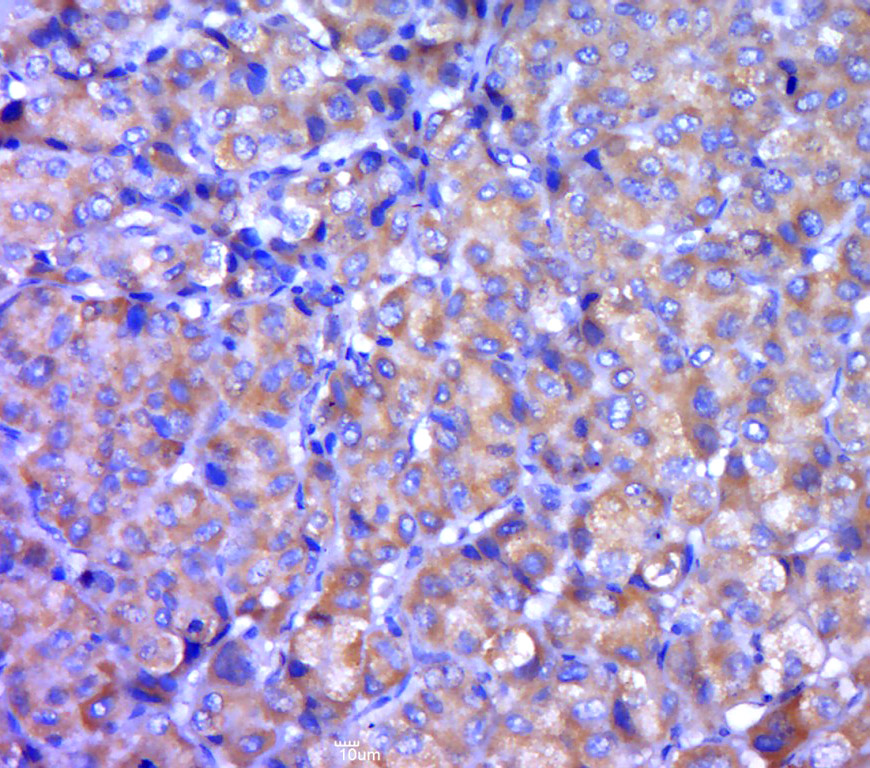
Rabbit Anti-DISC1 (CT)antibody
disrupted in schizophrenia1; C1orf136; KIAA0457; RP4-730B13.1; SCZD9; DISC1; DISC1_HUMAN.
View History [Clear]
Details
Product Name DISC1 (CT) Chinese Name DISC1 C端抗体 Alias disrupted in schizophrenia1; C1orf136; KIAA0457; RP4-730B13.1; SCZD9; DISC1; DISC1_HUMAN. Research Area Cell biology Neurobiology Alzheimer's Immunogen Species Rabbit Clonality Polyclonal React Species Human, Applications ELISA=1:5000-10000 IHC-P=1:100-500 IHC-F=1:100-500 IF=1:100-500 (Paraffin sections need antigen repair)
not yet tested in other applications.
optimal dilutions/concentrations should be determined by the end user.Theoretical molecular weight 92kDa Cellular localization cytoplasmic The cell membrane Form Liquid Concentration 1mg/ml immunogen KLH conjugated synthetic peptide derived from human DISC1: 761-832/854 Lsotype IgG Purification affinity purified by Protein A Buffer Solution 0.01M TBS(pH7.4) with 1% BSA, 0.03% Proclin300 and 50% Glycerol. Storage Shipped at 4℃. Store at -20 °C for one year. Avoid repeated freeze/thaw cycles. Attention This product as supplied is intended for research use only, not for use in human, therapeutic or diagnostic applications. PubMed PubMed Product Detail This gene encodes a protein with multiple coiled coil motifs which is located in the nucleus, cytoplasm and mitochondria. The protein is involved in neurite outgrowth and cortical development through its interaction with other proteins. This gene is disrupted in a t(1;11)(q42.1;q14.3) translocation which segregates with schizophrenia and related psychiatric disorders in a large Scottish family. Alternate transcriptional splice variants, encoding different isoforms, have been characterized. [provided by RefSeq, Jul 2008].
Function:
Involved in the regulation of multiple aspects of embryonic and adult neurogenesis. Required for neural progenitor proliferation in the ventrical/subventrical zone during embryonic brain development and in the adult dentate gyrus of the hippocampus. Participates in the Wnt-mediated neural progenitor proliferation as a positive regulator by modulating GSK3B activity and CTNNB1 abundance. Plays a role as a modulator of the AKT-mTOR signaling pathway controlling the tempo of the process of newborn neurons integration during adult neurogenesis, including neuron positioning, dendritic development and synapse formation. Inhibits the activation of AKT-mTOR signaling upon interaction with CCDC88A. Regulates the migration of early-born granule cell precursors toward the dentate gyrus during the hippocampal development. Plays a role, together with PCNT, in the microtubule network formation.
Subunit:
Interacts with NDEL1. Interacts with CCDC88A (via C-terminus); the interaction is direct. Interacts with GSK3B. Interacts with tubulin alpha, ACTN2, ANKHD1, ATF4, ATF5, CEP63, EIF3S3, MAP1A, NDEL1, PAFAH1B1, RANBP9, SPTBN4, SYNE1 and TRAF3IP1. Interaction with microtubules may be mediated in part by TRAF3IP1. Interacts (via C-terminal) with PCNT. Interacts with CHCHD6.
Subcellular Location:
Cytoplasm. Cytoplasm, cytoskeleton. ytoplasm, cytoskeleton, centrosome. Cell junction, synapse, postsynaptic cell membrane, postsynaptic density. Note=Colocalizes with NDEL1 in the perinuclear region and the centrosome. Localizes to punctate cytoplasmic foci which overlap in part with mitochondria. Colocalizes with PCNT at the centrosome.
Tissue Specificity:
Ubiquitous. Highly expressed in the dentate gyrus of the hippocampus. Also expressed in the temporal and parahippocampal cortices and cells of the white matter.
DISEASE:
Note=A chromosomal aberration involving DISC1 segregates with schizophrenia and related psychiatric disorders in a large Scottish family. Translocation t(1;11)(q42.1;q14.3). The truncated DISC1 protein produced by this translocation is unable to interact with ATF4, ATF5 and NDEL1.
Schizophrenia 9 (SCZD9) [MIM:604906]: A complex, multifactorial psychotic disorder or group of disorders characterized by disturbances in the form and content of thought (e.g. delusions, hallucinations), in mood (e.g. inappropriate affect), in sense of self and relationship to the external world (e.g. loss of ego boundaries, withdrawal), and in behavior (e.g bizarre or apparently purposeless behavior). Although it affects emotions, it is distinguished from mood disorders in which such disturbances are primary. Similarly, there may be mild impairment of cognitive function, and it is distinguished from the dementias in which disturbed cognitive function is considered primary. Some patients manifest schizophrenic as well as bipolar disorder symptoms and are often given the diagnosis of schizoaffective disorder. Note=Disease susceptibility is associated with variations affecting the gene represented in this entry.
SWISS:
Q9NRI5
Gene ID:
27185
Database links:Entrez Gene: 27185 Human
Omim: 605210 Human
SwissProt: Q9NRI5 Human
Unigene: 13318 Human
DISC1基因是蛋白质复合体中的一部分,它对大脑皮层发育过程中细胞的正常运动很重要。
DISC-1基因的变异增加了患精神分裂症的风险。研究人员发现,抑制老鼠的DISC1活性则改变了动物大脑的发育,引起了大脑皮层轻微的变异,而在对精神分裂症病人进行尸检时在其大脑中见到了此变化。研究人员还发现将DISC1与对大脑发育和调节神经传递素水平很重要的分子信号路径联系起来,精神病患者的神经传递素水平往往是不正常的。
新研究显示DISC1蛋白质与一个叫PDE4B的酶相互作用,而影响信号传递分子cAMP的活性。这个信号传递系统过去在其它试验系统中被发现与学习、记忆、以及情绪有关,这与该系统中的变化可能促成精神分裂症是一致的。Product Picture
Partial purchase records(bought amounts latest0)
No one bought this product
User Comment(Total0User Comment Num)
- No comment



 +86 571 56623320
+86 571 56623320




